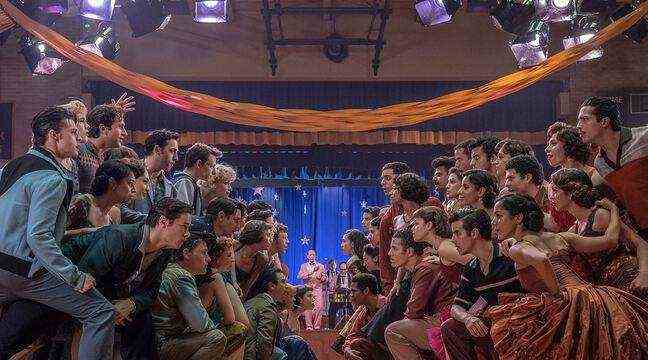It is a success ! The proofreading of West Side Story by Steven Spielberg is a marvel. Tony’s tragic loves (Ansel Elgort seen in Baby Driver) and Maria (Rachel Zegler making her screen debut), Romeo and Juliet from New York, take on a new dimension in a festival of sumptuous musical numbers that snap your fingers or bring tears to your eyes.
Steven Spielberg moves away from the version produced by Robert Wise and Jérome Robbins in 1961 and approaches the original 1957 play, a collaboration between musician Leonard Bernstein, lyricist Stephen Sondheim and playwright Arthur Laurents. He also took the liberty of changing or clarifying certain details to make the whole more dynamic. 20 minutes explains how the filmmaker managed to stay true to the spirit of West Side Story while modernizing it.
In 1957 or not at all
If the filmmaker found a current echo in this story which sets two rival bands, the Jets and the Sharks, against a background of racism, he did not want to transpose the action to our time. ” Never ! »He answers in French, when 20 minutes asks him about it. Steven Spielberg continues, in English this time: “It was essential to keep the action in the 1950s because at that time, there was still a gang war in New York. The white community, of which Tony is a part, clashes violently with the Puerto Ricans to whom Maria is related, which upsets their relationship.
“Puerto Ricans came to live the American dream in New York,” explains the filmmaker. They had jobs which was not the case with white people who were often delinquent and sometimes homeless. The latter were not fighting to protect their territory but out of pure xenophobia. »At that time, the promoter Robert moses had decided to destroy the district of San Juan Hill, in Manhattan, to build there among others the Lincoln Center. And the two communities will soon be driven out by rampant gentrification, a central element in the story, which makes their fratricidal struggle all the more poignant.
A history of women
Steven Spielberg also places a lot of emphasis on female characters. We even find there the actress Rita Moreno who was already in the 1961 film for which she received an Oscar. It offers a great moment of cinema when the aging and understanding pharmacist she plays in Spielberg’s version, crosses paths with Anita (sublime
Ariana DeBose), the vibrant Puerto Rican she once embodied for Robert Wise. These two women are at the center of the action bringing a positive force to the midst of belligerent boys that they will not be able to prevent from fighting.
“I love Robert Wise’s film,” specifies Steven Spielberg, “but it was a hybrid between theater and cinema. I wanted to differentiate our version from those that preceded it by making it more in line with the reality of the street. I wanted to show deeper relationships between the characters because we live in a complex world that screenwriter Tony Kushner pointed out by detailing the psychology of heroines and heroes. One thinks in particular of Anybodys (Iris Menas), “tomboy” in the film of Robert Wise, who is here clearly transgender. Times have changed in the way people are portrayed.
All for the music
West Side Story would have lost all its charm without its songs and dances that Steven Spielberg films with the gluttony of the little boy who discovered the musical with his mother. “I knew the songs before seeing Robert Wise’s film,” he explains. And I sang them in my head since I was a child, imagining myself dancing. Bringing them to the screen is a dream come true. One of the most beautiful sequences is undoubtedly that ofAmerica where Puerto Ricans talk about their New York experience. They dream of social promotion and they see a much more prosaic reality in this legendary air which is reminiscent of today’s migrants. The romantic duets between Maria and Tony are also very touching like the magnificent sequence I feel pretty, last moment of happiness for the female characters.
There is a lot of emotion and magic in this West Side Story virtuoso who, from his dizzying opening sequence, plunges the viewer into a New York that has disappeared and yet is deeply current. For his first musical, Steven Spielberg shows that he is still and probably for a long time to come, a master of the 7th Art.

